Known as the Eternal City, Italy’s Rome is one of the world’s most visited places. And with so much history found here, it’s the ideal place to take photos!
This is a city where you’ll focus on traditional architecture, culture and, of course, food. So learn about Rome photography in this guide.
Here are the best photo spots to help you get those stunning photos!
10. Rome Photography: 10. Trevi Fountain
The Trevi fountain was completed in 1762, and today stands as one of Rome’s most popular tourist attractions. It’s not as popular as the Colosseum, or the Vatican, but still attracts large crowds.
The statues of the fountain make excellent backdrops for portrait photos. This is not lost on the throngs of people take photos of themselves and each other at this photo spot.
As a photographer you have two options, to embrace those crowds, or try to avoid them.
- Include the crowds – Crowds can provide an important narrative element to a photo, giving the image context and life. To get the best of crowds in a photo you’ll want to get above them.
- Avoid the crowds – There are two main ways to increase your chances of photographing a monument without the crowds. The first is to wake up early in the morning, the second is to travel during the low season.
Best time to visit – Early in the morning, before the crowds.
Location – The Trevi Fountain
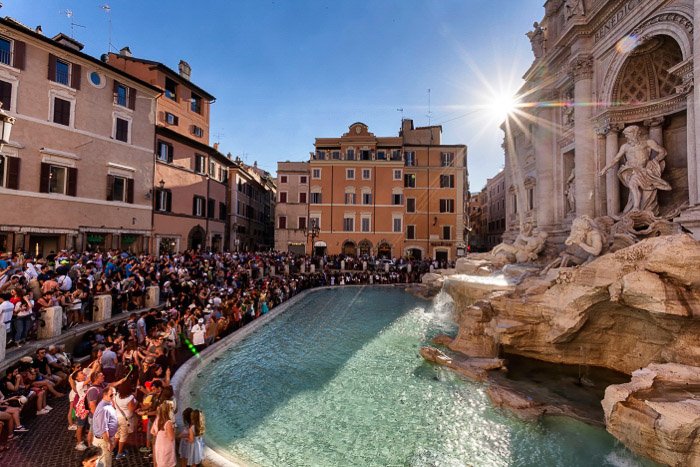
9. The Vatican Museum
The Vatican museum houses one of the world’s most important collections of artwork. There will be parts of this museum you won’t be able to photograph. Even those you can, crowds of people will still make it difficult.
There is some amazing roof architecture worth capturing, but the real gem for photographers in this museum is the spiral staircase.
The Vatican Staircase
The Vatican staircase is going to be one of your main Rome photography targets. It’s beautiful to photograph from the top looking down, from the bottom looking up, and midway along.
It’s also crowded with people, and they don’t really add to the photo. There is the option of arriving early, the problem is other people may arrive early as well. That’s because the queues to get in are often very long indeed, giving regular tourists the motivation to arrive early as well.
So what are the other options? The answer is layering, and using this to remove the people.
Removing People From a Scene
The following is used to take the classic photo of these stairs, from the top looking down.
- Compose your photo, you’ll want to go as wide as you can to capture those swirling stairs.
- Make sure you’re nice and steady, and can hold your position for the duration of the photo sequence.
- Take a series of photos, you’ll likely need at least 20. Take a burst of 5 or 6 photos as the crowds move down the staircase, wait a while and then take another burst of photos.
- Ensure your composition stays exactly the same throughout. As you can’t use a tripod, you will have to concentrate on staying very still.
- Import these images into Photoshop. You’ll need to make sure the photos are all aligned. Layer the photos on top of each other, then go to Edit>Auto-Align Layers.
- Now select all the images again. Next go to Files>Script>Statistics. From the menu that appears choose the median option. This will remove non-stationary object from your image, in theory leaving you with an image containing no people.
- It’s possible you will have some areas of the image that either still contain people, or a blurry area where people moved. Should this be the case you’ll need to clone out the areas of concern, but these should be small after using the automated script.
Best time to visit – Arrive early to avoid waiting several hours in a queue.
Location – The Vatican Museum
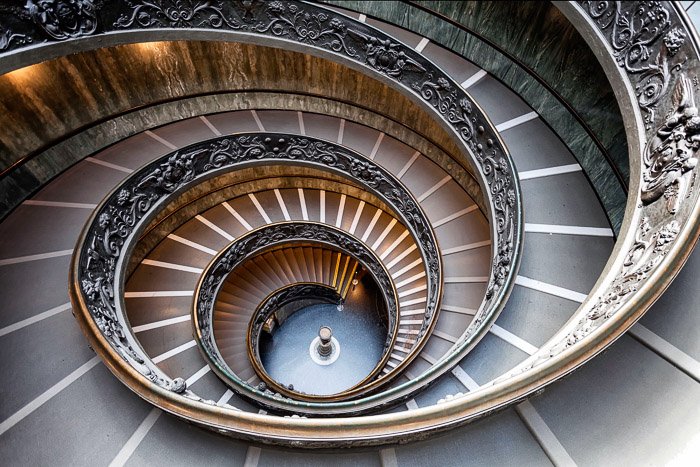
8. The Colosseum
Of the New 7 Wonders of the World, the only one to be found in Europe is in Rome, and it’s the Colosseum.
There are plenty of good options for photographing this masterpiece, so let’s look at some of the potential photographs you could take.
- The wider scene – Capturing the Colosseum from a vantage point is possible from the area just in front of the building. Use a wide angle lens to capture the building from an elevation.
- Traffic trail long exposure – At street level it’s possible to capture bus light trails and the Colosseum in the same image. You won’t see cars drive past the front of this building. If you wait patiently for buses, these provide excellent light streams.
- Detail photos – Photos of the side of the building and its architecture work very well. Use the evening sunshine to get a nice warm glow as you photograph the window arches of the Colosseum.
- Wide angle from inside – There are several view platforms inside the Coloseum that will give you a nice view. Once again a wide angle lens is best.
- Dawn – Arriving at dawn means being able to photograph the Colosseum with no people. You’ll also be able to capture the sun peaking through the windows of the Colosseum, as the sun is low to the horizon.
Best time to visit – Sunrise or blue hour.
Location – The Colosseum
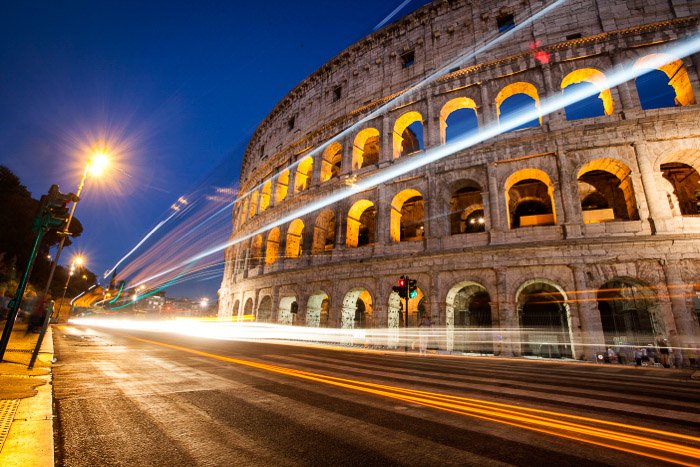
7. The Roman Forum
Around the corner from the Colosseum is the vast expanse of what was once an important location in ancient Rome.
This is an area that will give you the chance to photograph old decaying buildings, gardens, and lines of pillars. There are some nice vantage points to take photographs of this wider area, to get a sense of the scale of the place.
To get the most of this area take some wide angle photos from various vantage points. Use a longer focal length to take some detail photos as well.
Best time to visit – Early morning, perhaps after seeing the Colosseum.
Location – The Roman Forum
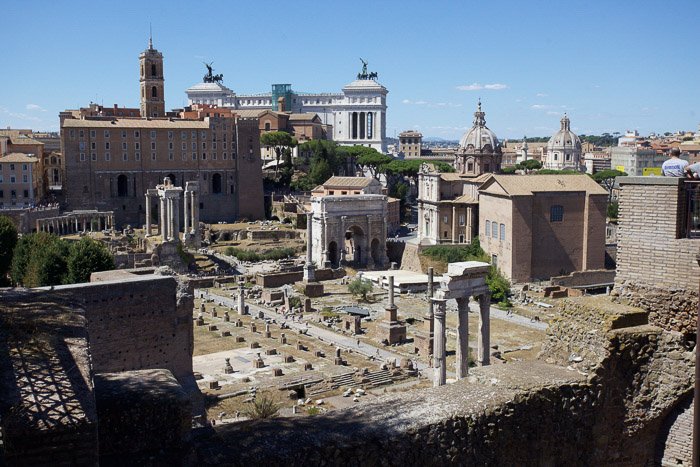
6. The Pantheon
In the center of Rome is the Pantheon, yet another iconic building in Rome which you’ll want to photograph. It’s a building that’s equally nice to photograph from the exterior and the interior.
One of the best times to photograph the building from the outside is the blue hour. It will be lit up, and you’ll have the blue skies to contrast against the yellow glow of the illumination of the Pantheon.
The issue is avoiding the crowds once again. You might opt for the morning blue hour, before sunrise. The other choice is to use post processing to remove people.
The interior also presents good photos in the form of the roof of the pantheon, and the various statues you can find inside the building.
Best time to visit – The blue hour.
Location – The Pantheon
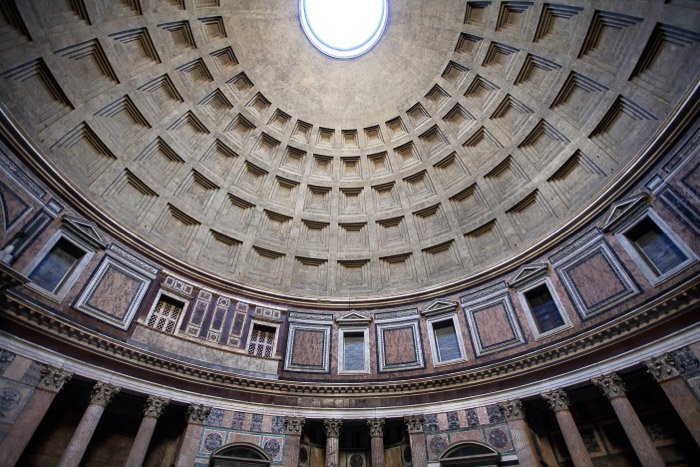
5. St Peter’s Basilica
The other part of the Vatican that’s popular to visit is St Peter’s Basilica, with Piazza San Pietro right in front of it. This is an area of the Vatican that’s not walled off, so you can freely wander in here.
If you’re lucky, you might see the Pope. Should you be there on such a day bring a long telephoto lens with you. You’ll not get close enough to photograph the Pope without it.
Beyond photographing the Pope there are two main reasons you’d want to photograph at St Peter’s Basilica.
- Church architecture – Architecture in religious building is meant to impress. That’s certainly the case at St Peter’s. So get that wide angle lens out, and do some interior architecture photography.
- The viewpoint – This is a great place to visit for your Rome photography, with a nice view over the city.
Best time to visit – Early morning around sunrise, or the hour before sunset.
Location – St Peter’s Basilica
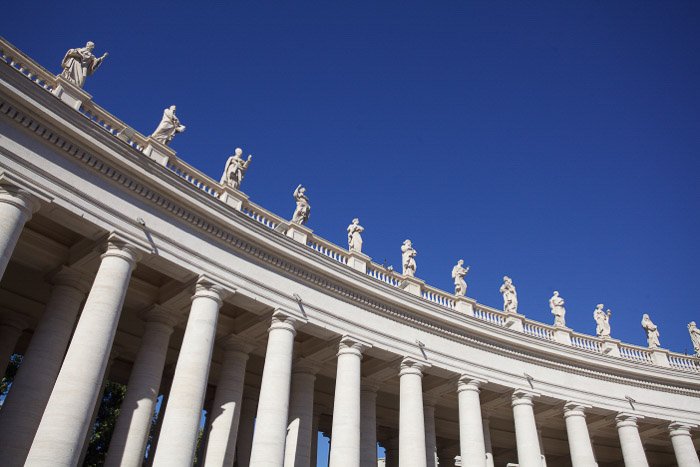
4. The Tiber River
The views along the rivers of most major cities are impressive. Rome is no exception, and the river Tiber offers photographers a number of good photographic options.
There are lots of points along this river that you could use. Here are three of the most popular choices.
- The view to St Peter’s Basilica – The view down to St Peter’s from Ponte Sant’Angelo is one of the best in Rome. Certainly the best along the river Tiber. Aim for sunset and blue hour to make the best of this location.
- Castel Sant’Angelo – Looking along the same bridge, Ponte Sant’Angelo, is Castel Sant’Angelo. The lines of the bridge leading up to the Castel offer another great photo from this location.
- Street photography – It’s always good to practice some street photography, as this will enhance your Rome photography portfolio. The areas around the river bank offer good opportunities for this, with street artists going about their day.
Best time to visit – The blue hour
Location – Ponte Sant’Angelo
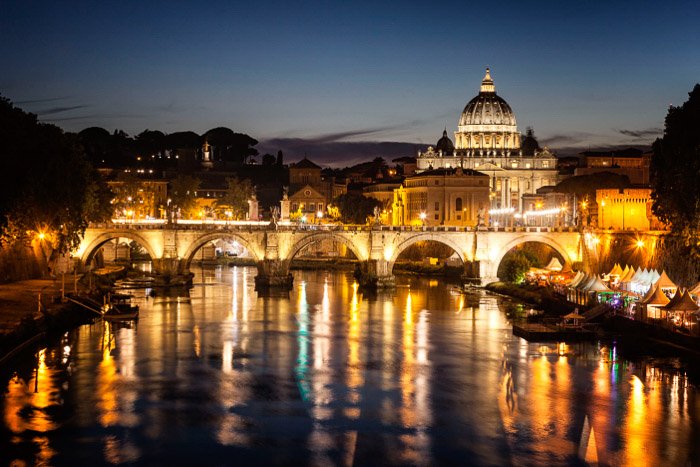
3. Altare della Patria
The Altare della Patria (Altar of the Fatherland) is an immense structure with striking architecture. It’s great to photograph, and offers the chance to do some cityscape work.
The proximity to busy roads will also give you the chance to juxtapose modern traffic light trails against an old traditional building.
As it’s located just in front of the Roman forum it will often be very crowded. That means arriving early in the morning if you want to photograph this building with less people wandering around.
It’s good to photograph up close to get some architectural detail photos. Another location is from Piazza Venezia, from where you can use the rule of thirds to compose a nice photo of the Altar.
Best time to visit – Early in the morning, or perhaps blue hour in the evening.
Location – Altare della Patria
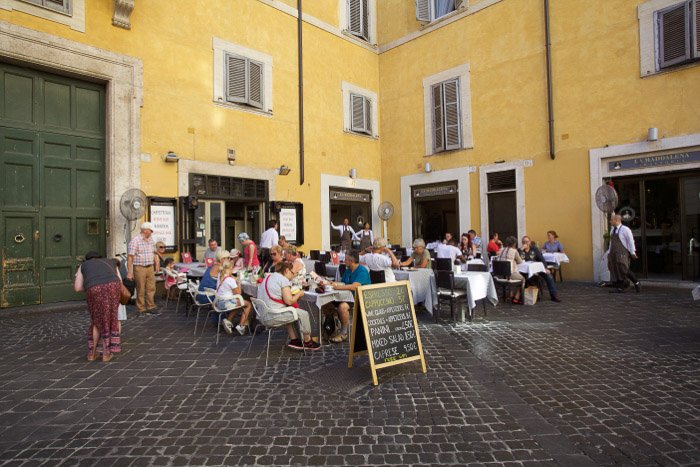
2. Piazza Navona
Piazza Navona is Rome’s central square. It’s always busy. It’s an area you should include in your Rome photography for several reasons. The first are the good opportunities for street photography. You’ll find lots of life here, as people enjoy the fountains, browse the various street artists work, and go about their day.
The second reason are the surrounding traditional buildings. These make for a nice photo of a traditionally Roman scene.
Best time to visit – Early in the morning
Location – Piazza Navona
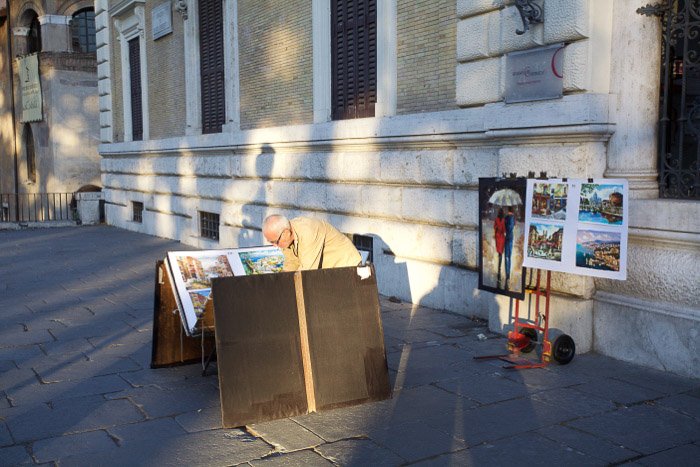
1. Piazza del Popolo
The last stop on our list is another square, which offers something a little different from the others. This is a cobblestone square that’s been pedestrianized. It’s surrounded by lots of nice old buildings, in other words it’s another very picturesque square in Rome.
There will be plenty of photos to take from street level here. The photo to take for your Rome photography is from a vantage point though.
Towards the back of the Piazza you’ll find some steps that lead to a vantage point overlooking it. Take a photo of the Piazza extending down through Rome with the dome of St Peter’s basilica in the background.
Best time to visit – Sunset and the evening blue hour.
Location – Piazza del Popolo
Equipment
To capture these locations for your Rome photography, here are a few essentials you should pack:
Tripod – You can’t use it everywhere, but it’s vital for any good travel photography.
Various lenses – Make sure you cover your focal lengths with a good wide angle lens and a telephoto lens. Also grab a 50mm prime lens for some street photography.
You’ll certainly need more than a few days to make the most of your photography in Rome.
If you can avoid the height of summer you’ll be able to enjoy Rome at a less oppressive temperature, and you’ll also likely have fewer crowds to deal with in general.
Rome is a nice city to walk through, but don’t discount the excellent tram system that will get you around the city a little quicker so you can focus more on photography.
Looking for more travel photography tips? Check out our new post about the best architecture photography locations next!